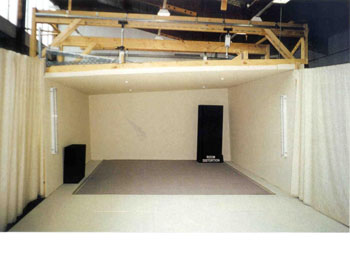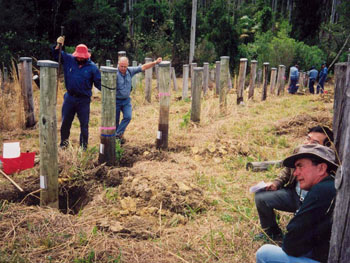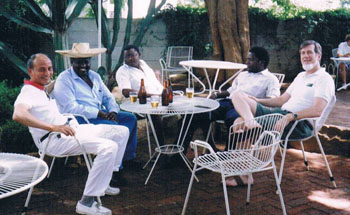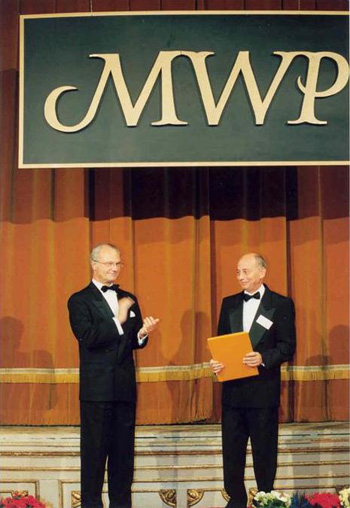Engineered performance of timber
Prior to 1970 when this research commenced, the design of structures was essentially based on past experience and rule-of-thumb compliance procedures. The performance obtained was unknown and unspecified; structures may have been unduly safe, be at risk from rare loads or human error, and may have involved considerable risks when applied to changed load, environmental and structural conditions.
The alternative proposed was to develop design procedures based on risk management principles. During the period 1975-1985, Bob Leicester led an Australian team that developed a formal procedure for drafting reliability-based design rules for structural engineering. This procedure which takes into account uncertainties of loads, environmental factors, material properties, structural engineering concepts and human behaviour, has since been adopted for drafting most Australian structural engineering standards.
In order to draft performance based design standards, Bob developed several analytical and prediction models of structural performance. These included models to predict structural failure due to buckling (distortion effects), fracture, mechano-sorptive effects, attack by fire and material degradation; as well as models of human response and behaviour.
Bob always maintained a special interest in timber construction and drafted several performance-based Australian and International standards related to timber use. Some of these standards are related to the assessment of material properties and so are also relevant to the international trade of timber. Accordingly Bob has taken part in several government trade missions related to trade in building materials.
Timber design in Australia is applicable to the use of mixed hardwood species. This feature is very similar to the situation in many developing countries, but is quite foreign to the technologies developed in Europe and North America. This has led to many invitations for Bob Leicester to undertake overseas assignments to introduce CSIRO’s technology into countries in South America, Africa and South-East Asia. Some of these visits have been sponsored by Australian aid agencies such as Australian Centre for International Agricultural Research (ACIAR), but most have been sponsored by international agencies such as United Nations Industrial Development Organisation (UNIDO).
The need for change
In 1970 the design rules in structural design codes were based largely on following past experience. Design engineers were quite happy with this and did not favour any change in these rules. However when a change in the structural scenario did eventuate (such as new materials or loads), there was usually considerable disagreement between the engineering experts as to what new design rules should be applied.
Bob Leicester suspected that the use of risk-based procedures would provide reasonable alternatives to the plethora of conflicting opinions; it would also provide a rational framework into which any data obtained could be entered to assist in producing a rational result.
Probability methods
His initial use of probabilistic methods showed that they worked reasonably well for this purpose. The application of probability methods starts with a definition of the target performance, stated in risk or probabilistic terms. Typically this will be the probability of structural collapse or the probability that a building occupant will be unsatisfied with the functionality of the building.
Although Monte Carlo techniques could have been used to find the solution of any specific statistical problem, Bob was encouraged to chase after closed form solutions because of the ease with which these could be applied in the drafting of design rules. Typically these solutions would be computed probabilities of failure or alternatively computed cost-optimised risks. The closed form solutions were found to work quite well for drafting design rules, but strangely there has been very few attempts by other researchers to follow this path.
Encouraged by the success of using probabilistic methods for practical purposes, Bob organised Australia’s first Conference on The Application of Probability Theory to Structural Design, in Melbourne, 1974.
The situation becomes more complex
The above approach proved adequate for dealing with issues within a single design code, such as a structural code for the design of timber structures (AS 1720.1 – Timber Structures. Part 1: Design Methods). However about this time it was decided that all structural design codes in Australia would be enmeshed within a common Limit States Design format that linked both material and loading codes. The link would be common performance targets; so for example, steel structures and timber structures intended for the same application would be designed for the same performance, i.e. the same safety against collapse.
The problem was now more complex. For a start, all similar structures would be designed for the same combination of loads, such as gravity, wind, earthquake etc. As Chairman of BD6, the Standards Australia committee charged with drafting a standard on load combinations (AS 1170.1 – SAA Loading Code. Part 1: Dead and Live loads and load combinations), Bob Leicester was pulled vigorously in various directions by chairmen of the various material and loading codes committees. For example, a Chairman for a committee on multi-storey concrete structures would be influenced by the fact that a high gravity loading component would place these buildings at a competitive disadvantage, whereas another Chairman would note that for steel sheds a high wind load component did likewise. In fact initially the chairmen of many standards committees argued strongly against using a probabilistic procedure. You cannot compute risk
The approach used by Bob’s committee was to recommend that all characteristic values of strength and load components be defined in probabilistic terms, and that the design equations used would then be checked via a formal probabilistic framework to ensure that appropriate building performance targets were met. Fortunately about this time, researchers around the world were developing techniques which could be adapted for this purpose. Bob assembled a team (comprising John Holmes and Lam Pham of CSIRO and Peter Kleeman of the University of Newcastle) which then set about the lengthy task of gathering the data and writing the necessary software to work the probabilistic paradigm. Eventually most chairmen agreed to accept, or at least make use of the recommendations from this committee. One unusual aspect about the Australian approach was that in this approach, real rather than a notional, probability of failure was used as the performance target.
CSIRO’s prediction models
Serviceability
Serviceability refers to functionality from a human viewpoint; structural collapse is excluded. Examples of unserviceability include the physiological and emotional effects on a building occupant of floor vibrations, building sway, sloping floors, distorted walls and the appearance of cracks. Bob placed the problem within an effective probabilistic paradigm but needed better quantitative human response parameters to complete the model. To do this he borrowed a couple of abandoned laboratories at the CSIRO Highett site and built a series of test environments. The test environments comprised rooms within which the parameters related to unserviceability could be manipulated. Bob was ready to recruit subjects for the tests when an unseen flagship sailed straight through the project and shanghaied the technical staff. It would have been an exciting world first.

Fracture mechanics
If conventional methods are used to undertake a stress analysis of an element containing a sharp notch, one or more mathematical singularities are obtained at the notch root. In classical linear elastic fracture mechanics, the load to initiate fracture at the notch root is related to the strength of these mathematical singularities. To date, Bob Leicester, together with his colleague Paul Walsh, have been the only researchers to develop a generic method to evaluate these singularities for the general case of non-zero angle notches, and to apply the results within the formal framework of a design code (AS 1720.1 – Timber Structures. Part 1: Design methods).
An interesting feature that follows on from a linear elastic fracture mechanics analysis is that if two geometrically similar bodies are similarly loaded, the larger one will fail at a lower stress level than the smaller one, provided that the two bodies are both larger than a certain critical size. This significant structural fact is still not widely appreciated.
In 1974, Bob Leicester organised Australia’s first conference on fracture mechanics, in Melbourne. Since then there have been many such conferences. It is amusing to recall that just prior to that first conference, the steel industry had organised a Workshop with the aim of forming the Australian Fracture Mechanics Group; however at their meeting there were vociferous statements to the effect that Fracture mechanics does not work
Mechano-sorptive deformation and buckling
Mechano-sorptive deformation refers to the enhanced deformation of wood under the combined effects of stress and moisture desorption. Bob Leicester extended the existing CSIRO work to develop a model suitable for structural application. It has been applied to predict the buckling strength of timber elements such as beams and columns and also to the long term structural performance of joints using metal connectors.
The slenderness of structures can have a significant impact on reducing their load carrying capacities; and for timber structures this effect is amplified by mechano-sorptive effects. The analysis of slenderness effects to determine this buckling strength of a structure is complex, particularly in the application to timber where in addition to mechano-sorptive creep, the effects of material orthotropicity and the random dispersion of defects must all be considered. Bob Leicester has undertaken studies on a wide range of timber elements that includes beams, columns, and plate elements such as plywood webs. In some instances these studies led to considerable increases on the existing design load capacities; for example there were increases of up to 50% in the case of columns and 400% in the case of plywood webs.
The paper considered by Bob as the most outstanding mathematical paper of his career was developed as part of this project. It concerns a linear one-dimensional eigenvalue analysis of two coupled parameters. Alas, few academics are aware of it; and every few years someone re-discovers the original problem in structural buckling that triggered this study (Leicester RH, 1970, ‘Southwell plot for beam-columns’, Journal of the Engineering Mechanics Division, 96: 945-965).
Product appraisal
In his early work, Bob was a world leader in the development of criteria for the acceptance of structures based on proof testing and prototype testing of completed structures.
However his most useful research for product appraisal was that related to stress-graded lumber. Timber cut from a single tree will vary in strength through a range of roughly 10:1; hence before timber can be used for structural applications, its variability must be reduced by first being sorted into structural grades. This sorting process is known as ‘stress-grading’.
Bob’s key contribution in this area was to draft standards related to product appraisal (Australian standard AS 4063 – Timber-Stress-graded – In-grade strength and stiffness evaluation), and to propose procedures for quality control. In performance based standards, the 5-percentile strength value of each lumber population is taken to be the characteristic value; this is a property that is very difficult to measure and control efficiently as timber is highly variable both within a piece of wood and from piece to piece. As an example, to evaluate all the important properties for every size and grade for a typical softwood species with current procedures, about 10 000 pieces need to be tested at a cost of about $1 000 000. The production of reliable stress-graded timber is a sophisticated and expensive undertaking.
Bob Leicester was also involved in developing a couple of stress-grading technologies. The first was a technique called ‘proof-grading’, a method of grading based on the use of a continuous loading machine. An Australian standard for this grading process was drafted (Australian Standard AS 3519 – Timber-Machine proof grading), and at one time there were several Australian mills using the process. It is extremely simple to apply, and (since it ignores the use of botanical features as grading parameters) it is very suitable for a mixture of unidentified species; it would be ideal for application in a developing country utilising mixtures of hardwood species.
The proof-grading project led to many interesting material studies, including a study of the properties of timber that had been pre-loaded. Using some of this data, Bob had the pleasure of presenting a unique paper on two-cycle fatigue at an aeronautical conference (Leicester RH, 1990, ‘Failure in two-cycle fatigue’, Theoretical and Applied Fracture Mechanics, 13: 161-164).
A second technique developed was one targeted at efficient high-speed stress-grading. It was based on the use of non-contacting microwave scanners to measure knots, slope-of-grain and juvenile wood as the lumber passed through a machine at high speed. A US patent (Number 5,619,143 untitled ‘Microwave scanning apparatus’) was taken out for the system and initial mill trials undertaken. At the time of his retirement the project had not been completed and Bob recommended that the system be given away to a suitable equipment manufacturer; but alas this was not in line with CSIRO policy.

Fire
Research by Bob Leicester led to the drafting of an Australian standard for the design of structural timber and timber connectors attacked by fire (AS 1720.4 – Fire resistance of structural timber members). An unexpected finding (unknown until that time) was that the timber need not be charred for a metal connector joint to fail; the reason is that once the metal temperature passed above 200 ºC, it was hot enough to soften the contacting wood to the point that it lost it’s required bearing strength.
During this time, Bob had the privilege of joining a team that submitted a case for the use of combustible material within the fire-separation walls of multi-occupancy dwellings. The argument put forward for the case was a perfect example of performance based concepts; it was successfully argued that the performance target was life and property safety, and not the combustibility of material. The successful presentation was based on a reliability analysis focused on a model of building and occupant safety.
Wind and cyclones
In 1970 Bob and his CSIRO team-mate Greg Reardon began to investigate wind damage using formal structural engineering principals. It was an Australian first, probably a world first. Following initial studies, a CSIRO group toured the major cities of Australia to present a Workshop, titled ‘Keep Your Roof on’, intended to encourage builders to use design concepts derived through the application of these engineering principles. The ideas promoted were seminal to the development of our current standards on wind resistance for housing. But at that time the CSIRO proposals were met with hostility by many builders and even a few engineers who preferred to rely on their past experience.
However attitudes changed after cyclone Tracy destroyed Darwin in 1974. The survey of the damage by Bob and Greg, involved almost 3 000 houses and industrial buildings, the largest survey of this type to have been done in Australia (Leicester RH, Reardon GF, 1976, ‘A statistical analysis of structural damage by cyclone Tracy’, Civil Engineering Transactions, Institution of Engineers, Australia, pp.50-54). That disaster triggered a 10-year investigation by Bob Leicester of wind damage and building construction around Australia. The data obtained during these studies was used for a project (organised by Charles Bubb of the national Department of Housing and Construction) to develop a prediction model for future damage by cyclones to Australian housing.
A significant finding of these wind-damage investigations was that for rare events such as cyclones, the risk of structural collapse was not due primarily to material properties, rather it was due to human error by builders who typically have no formal training in structural engineering. Thus when an unusual event occurs the application of traditional technology will often prove to be inadequate. This concern by Bob has yet to be accepted and incorporated in the drafting of building regulations in Australia. These regulations are currently based on the concept of stitching together conventional cottage construction; what is required is that within each house or construction, there resides a simple anchor structure that can be reliably built. The same procedure should also apply to the construction of houses to resist all other natural hazards, including earthquakes. This concept is even more important when applied to developing countries.


Durability
It has been appreciated for some time that a weak link in the development of performance based design has been the lack of suitable models to predict the strength degradation of timber structures. Following the successful presentation with CSIRO colleague John Barnacle of a seminal paper at a conference in 1990, Bob Leicester teamed up with industry colleague Colin McKenzie to obtain funding for a major effort to develop such models. Initially the industry technologists were extremely sceptical that useful models could be developed; they were not familiar with the use of probabilistic concepts to cope with uncertainty. You can’t predict where a termite will go
This project was a world first and was awarded the 2006 Wood Engineering Achievement Award by the Forest Products Research Society (USA), the first time that this award has been given to a group outside North America.

An interesting footnote to this project is that much of the success of the early phase of the project was due to the fact that Bob Leicester managed to employ a couple of excellent CSIRO research scientists (Gary Johnson and John Thornton) who had recently been made redundant on the grounds that their work was largely uninteresting data collecting. Their data proved invaluable to the durability project.
International applications – tropical countries
Australia is in a good position to assist tropical countries in the utilisation of structural timber, because both use mixed hardwood species. During the years Bob Leicester visited many tropical countries either to run training workshops or to act as a specialist consultant. Countries visited (usually more than once) include Brazil, Guyana, Ghana, Zimbabwe, South Africa, Kenya, Myanmar, China, Philippines, Fiji, Malaysia, and Indonesia. Sponsors for these trips included: the United Nations Industrial Development Organisation (UNIDO), the International Tropical Timber Organisation (ITTO), the United Nations Economic and Social Commission for Asia and the Pacific (ESCAP), the Australian International Development Assistance Bureau (AIDAB) and the Australian Centre for International Agricultural Research (ACIAR).
Bob has always had a concern as to whether his workshops in developing countries have had any long term technological impact and has persuaded UNIDO to undertake surveys on this matter. One example that Bob initiated for this purpose occurred within an ITTO project with the Philippines. The project was originally titled ‘Development of a system for stress-grading mixed hardwoods’. Bob was keen to ensure that at the end of the project the technology developed would not disappear under the usual mantle of shelf dust. Accordingly he persuaded ITTO and the Philippines to amend the title to ‘Development and implementation of a system for stress-grading mixed hardwoods’. The small change in the project title made for a totally different, very interesting, useful and holistic project. It took the project out of the laboratory and into all aspects of supply, implementation of technology, marketing, standardisation, quality control and building design. Hopefully this particular project will survive and expand in scope and international application. In fact the holistic nature of the project provided Bob with some useful insights for his own work within the timber industry back in Australia.

Honours and awards
For his outstanding contributions to predicting structural performance Bob Leicester has received the following awards:
|
2006 |
Wood Engineering Achievement Award (Forest Products Society, USA) – the first time this has been awarded to a group outside North America |
|
2004 |
Distinguished Alumni Award, University of Illinois, USA |
|
2000 |
The Marcus Wallenberg Prize presented by HM King Carl XVI Gustav, Stockholm, Sweden. This prize is often referred to as the forest’s and forest industry’s ‘Nobel prize’, valued at 2 million Swedish kroner |
|
1998 |
CSIRO Medal for research Achievement |
|
1992 |
The Stanley Clark Medal for Wood Science (from the Institute of Wood Science UK) |
|
1960 |
Edward Noyes Prize, Institution of Engineers, Australia (1960) |

Source
- Leicester RH, 2009, Personal communication.
